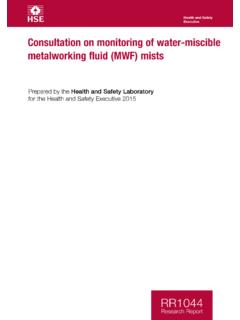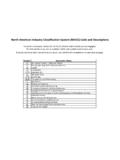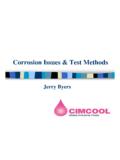Transcription of Metalworking fluids—Mechanisms and performance
1 Metalworking fluids Mechanisms and performanceE. Brinksmeier (1)a, D. Meyera,*, Huesmann-Cordesa, C. Herrmann (2)baFoundation Institute of Materials Science, Department of Manufacturing Technologies, Badgasteiner Str. 3, Bremen 28359, GermanybInstitute of Machine Tools and Production Technology, Sustainable Manufacturing & Life Cycle Engineering, Langer Kamp 19 B, Braunschweig 38106, Germany1. IntroductionMetalworking fluids (MWFs) have been addressed in several CIRPK eynote Papers in the past as they play a significant role inmanufacturing processes such as forming [12], cutting [268], andgrinding [27]. They influence heat generation in metalworkingprocesses by reducing friction between tool and workpiece. Coolingis furthermore achieved by dissipating and conducting the generatedheat. By their lubricating and cooling properties, MWFs contribute tothe avoidance of thermal damage of the workpiece material andreduce wear of the tool [28].
2 They are of high relevance for thegeneration [29,100] and understanding [129] of the surface integrityin Metalworking . In machining processes chip transportation out ofthe working zone is a further important subtask of MWFs. Theresearch focus up to now has mainly been on phenomenologicalstudies looking at the improvement of the performance of certainmanufacturing processes by MWFs. Less effort was made to clarifytheir mechanism of action. However, the aforementioned researchbuilds the ideal basis for a cross-process discussion of the sharedworking mechanisms and the potential regarding knowledge-basedimprovements of the performance of et al. addressed environmental aspects of lubricants informing processes including approaches to substitute the MWF byapplying special coatings or structured workpiece and tool surfaces[12]. The authors give an excellent overview regarding the potentialof oil-based MWFs and emulsions to increase productivity ofdifferent forming processes.
3 Although models for the lubricationeffect of emulsions are briefly presented, the chemical workingmechanisms and the specific impact of varied MWF compositionson the process performance remained cutting processes, a comprehensive summary of thepotential to reduce MWF-consumption (for economic andenvironmental reasons) is given in the 2004 CIRP Keynote Paperby Weinert and colleagues, who present a definition of minimumquantity cooling and/or lubrication (MQL) approaches as well asscopes regarding the fields of application of both dry machiningand MQL [268]. Comparisons between the achievable tool life weremade and the requirements regarding tool materials and coatingswere et al. [27] focused on the avoidance of thermalworkpiece damage in grinding processes. Different commonconcepts of grinding fluids (chemical composition), the state ofthe art of MWF-supply (nozzles, nozzle positioning, and fluiddynamics) as well as comparative results from grinding experi-ments revealed the potential of MWFs to decrease the workpiecetemperature during focus has been given to the chemical interactions of thesurface of the workpiece material and the MWF.
4 Consequently, thispaper aims to reveal fundamentals of MWF-chemistry and thepresentation of theories on their working mechanisms. Further-more, a systematic overview on today s possible scenarios forfuture MWF-concepts are this purpose, this paper defines Metalworking fluids asliquids, which are supplied to a manufacturing process in a waythat allows for increased productivity based on lubricating andcooling effects. As general aspects of the fluids are discussed, whichare mainly independent from the manufacturing process, com-monly used terms such as coolant, lubricant, grinding oil, cuttingfluid are summarized as which are included in the term MWFs have beenclassified based on different criteria like formulation (oil-based,water-based), manufacturing process (cutting fluid, grinding oil,forming oil, etc.), or quantity (flooding, MQL, etc.). Not all of theseclassifications are suitable to discuss MWFs and their propertiesfrom a mechanism-oriented point of view.
5 According to DIN 51385,MWFs are classified following their composition as oil-based orwater-based MWFs [59]. Specific properties are achieved byCIRP Annals - Manufacturing Technology xxx (2015) xxx xxxA R T I C L E I N F OKeywords:MechanismPerformanceMetalworki ng FluidsA B S T R A C TIn various manufacturing processes, Metalworking fluids (MWFs) are applied to ensure workpiecequality, to reduce tool wear, and to improve process productivity. The specific chemical composition of anapplied MWF should be strongly dependent on the scope of application. Even small changes of the MWF-composition can influence the performance of MWFs in manufacturing processes considerably. Besidesdefined variations of the composition, the MWF-chemistry furthermore changes over the service life ofthe fluid. This paper presents the current state of the art regarding the assumed working mechanisms ofMWFs including the effects of desired and undesired changes of the MWF properties.
6 2015 CIRP. This is an open access article under the CC BY-NC-ND license ( ).* Corresponding author. Tel.: +49 421 218 address: (D. Meyer).G ModelCIRP-1401; No. of Pages 24 Please cite this article in press as: Brinksmeier E, et al. Metalworking fluids Mechanisms and performance . CIRP Annals -Manufacturing Technology (2015), lists available at ScienceDirectCIRP Annals - Manufacturing Technologyjournal homepage: 2015 CIRP. This is an open access article under the CC BY-NC-ND license ( ).adding specific chemical substances (additives). Fig. 1 shows theclassification of MWFs according to DIN 51385 and includes sometypical classes of additives, which will be addressed in more detailin Section of this lipophilic part of oil-based MWF may consist of natural,synthetic, and/or mineral oil: vegetable synthetic, naphthenic,paraffinic, or petroleum oil [11,138] (cf. Section ).
7 MWF-emulsions are stabilized to an oil-in-water (O/W) emulsion by anemulsifier system (often also referred to as surfactants or tensides).Emulsifier-molecules feature a hydrophilic and a lipophilic ambivalent molecules enclose the oil drops and thehydrophilic end of the emulsifier interacts with the MWFs are purchased as oil-based concentrates,which are dispersed with water at the place of use. Commondilution levels are concentrations of 3 10% of the MWF-concen-trate in water [36]. The droplets formed by emulsifiers (cf. Fig. 2)are called micelles. The oily phase inside the micelles includes alllipophilic to the lack of lipophilic parts, water-based solutions arefree of emulsifiers. In solutions, the water is additivated with activepolar hydrophilic substances. In Table 1, a comparison of a typical,general formulation of a solution, an emulsion and an oil-basedMWF is performance of a certain MWF is influenced by factors suchas the type of manufacturing process, the working material, andthe tool.
8 Oil-based MWFs are especially used in processeswhich require efficient lubrication whereas water-based MWFs areapplied when the dissipation of heat is more important thanlubrication. However, besides some general approaches for specificmanufacturing tasks (cf. Section ), the choice of the mostefficient MWF today still is experience-driven in most parameters influencing the performance of MWFs aresummarized in Fig. 3 including the sections of this paper, whichcover the relevant fields of this complex History and demand for MWFs in manufacturing technologyEarly approaches for the support of Metalworking processes byfluids utilize two basic properties of liquids: their ability to dissipateheat and to reduce friction by lubrication. Leonardo da Vinci createdseveral test set-ups allowing for the analysis of friction under variedconditions (Fig. 4). Beside of the use of pure fats and oils, early MWFswere mixtures of water (which has the highest heat transfercoefficient) and additional substances for the improvement of theMWFs properties, especially the lubrication products such as animal oils and fats (primarily whale oil,tallow, and lard)as wellas vegetable oils fromvarious sources such asolive, palm, castor, oil plant and other seed oils were used to composethe wereappliedin manufacturingprocesses forthe production of metal artwork and weapons in the middle age[36,62].
9 InfurtherworkofdaVinci,amixtureofoilandc orundumwasapplied for lubrication purposes in an internal cylindrical efficient supply of the MWF to the tool [284].In the early 19th century, the design of machine tools madeconsiderable progress and simultaneously, the techniques for theFig. 2. A micelle of an oil-in-water-emulsion, according to [17,82].Fig. 4. Leonardo da Vinci s sketches of tribological test set-ups for the analysis offriction [154].Table 1 Examples of formulations of MWFs of different types [36,207].Component Amount (wt %)Solution Emulsion (5%) Oil-based MWFM ineral oil 75 100 Emulsifiers Coupling agents pH buffer 5 Corrosion inhibitors 10 0 5 Extreme-pressure additives 4 0 5 20 Biocides 2 Unknown Antioxidants 0 2 Boundary lubricity additives 9 0 10 Water 70 95 Fig. 1. Classification of the MWF types according to DIN 51385 (simplified) [59,259].
10 Fig. 3. Parameters influencing the performance of MWFs. Encircled: sections of thispaper, addressing the corresponding Brinksmeier et al. / CIRP Annals - Manufacturing Technology xxx (2015) xxx xxx2G ModelCIRP-1401; No. of Pages 24 Please cite this article in press as: Brinksmeier E, et al. Metalworking fluids Mechanisms and performance . CIRP Annals -Manufacturing Technology (2015), of MWFs were improved [284]. In his autobiography [162]James Nasmyth describes his inventions, a traversing drill,which had a small tank to supply water or soap in water ( as alubricator ) directly to the contact zone. The increased availabilityof mineral oil around 1850 had an intense influence on thecomposition of MWFs. The oil, which was a by-product of refiningkerosene, was chosen to replace animal and vegetable oils in MWFsdue to its low price [62].At the end of the 19th century, the first systematic publicationsaddressed the lubricating effect of MWFs by means of the ability toreduce the friction between tool and workpiece.







